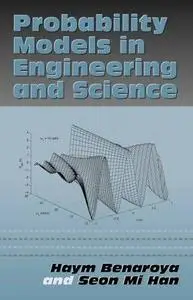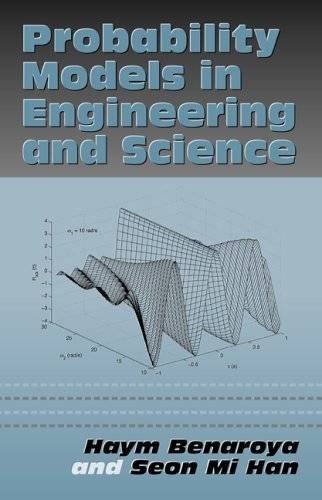Haym Benaroya and Seon Mi Han,
«Probability Models in Engineering and Science»
CRC | ISBN 0824723155 | June 24, 2005 | PDF | 10,3 Mb | 760 Pages
Thanks to Eusoof for the original upload!!
Probabilistic Models in Engineering and Science provides engineers, scientists, and students with a self-contained, comprehensive introduction to applied probabilistic modeling. Perfectly suited to undergraduate and graduate coursework, professional reference, or self-study, this book develops applied probability along with the historical context of the field, providing short biographies and portraits of key "names" mentioned in the book. The authors have included extensive example problems, ample end-of-chapter problems, and footnotes that provide references for further in-depth information. Topics include random processes, reliability, and the Monte Carlo method.
––
Certainty exists only in idealized models. Viewed as the quantification of uncertainties, probabilitry and random processes play a significant role in modern engineering, particularly in areas such as structural dynamics. Unlike this book, however, few texts develop applied probability in the practical manner appropriate for engineers.
Probability Models in Engineering and Science provides a comprehensive, self-contained introduction to applied probabilistic modeling. The first four chapters present basic concepts in probability and random variables, and while doing so, develop methods for static problems. The remaining chapters address dynamic problems, where time is a critical parameter in the randomness. Highlights of the presentation include numerous examples and illustrations and an engaging, human connection to the subject, achieved through short biographies of some of the key people in the field. End-of-chapter problems help solidify understanding and footnotes to the literature expand the discussions and introduce relevant journals and texts.
This book builds the background today's engineers need to deal explicitly with the scatter observed in experimental data and with intricate dynamic behavior. Designed for undergraduate and graduate coursework as well as self-study, the text's coverage of theory, approximation methods, and numerical methods make it equally valuable to practitioners.
# Offers an easy-to-follow approach that makes complex concepts accessible and relevant
# Includes a wealth of example problems, some that work to explain concepts and others that integrate several concepts to show how the theory works as a whole
# Contains many end-of-chapter exercises that reinforce concepts
# Devotes a chapter to fluid induced vibration that demonstrates the application of probabilistic models to offshore structural engineering
:::::::::::TABLE OF CONTENTS::::::::::::
INTRODUCTION
Applications
Units
Organization of the Text
Problems
EVENTS AND PROBABILITY
Sets
Probability
Concluding Summary
Problems
RANDOM VARIABLE MODELS
Probability Distribution Function
Probability Density Function
Mathematical Expectation
Variance
USEFUL PROBABILITY DENSITIES
Two Random Variables
Concluding Summary
Problems
FUNCTIONS OF RANDOM VARIABLES
Exact Functions of One Variable
Functions of Two or More RVs
General Case
Approximate Analysis
Monte Carlo Method
Concluding Summary
Problems
The Standard Normal Table
RANDOM PROCESSES
Basic Random Process Descriptors
Ensemble Averaging
Stationarity
Derivatives of Stationary Processes
Fourier Series and Fourier Transforms
Harmonic Processes
Power Spectra
Fourier Representation of a Random Process
Borgman's Method of Frequency Discretization
Concluding Summary
Problems
SINGLE DEGREE OF FREEDOM DYNAMICS
Motivating Examples
Deterministic SDoF Vibration
SDoF: The Response to Random Loads
Response to Two Random Loads
Concluding Summary
Problems
MULTI DEGREE OF FREEDOM VIBRATION
Deterministic Vibration
Response to Random Loads
Periodic Structures
Inverse Vibration
Random Eigenvalues
Concluding Summary
Problems
CONTINUOUS SYSTEM VIBRATION
Deterministic Continuous Systems
Sturm-Liouville Eigenvalue Problem
Deterministic Vibration
Random Vibration of Continuous System
Beams with Complex Loading
Concluding Summary
Problems
RELIABILITY
Introduction
First Excursion Failure
Fatigue Life Prediction
Concluding Summary
Problems
NONLINEAR DYNAMIC MODELS
Examples of Nonlinear Vibration
Fundamental Nonlinear Equations
Statistical Equivalent Linearization
Perturbation Methods
The van der Pol Equation
Markov Process Based Models
Concluding Summary
Problems
NONSTATIONARY MODELS
Some Applications
Envelope Function Model
Nonstationary Generalizations
Priestley's Model
SDoF Oscillator Response
Multi DoF Oscillator Response
Nonstationary and Nonlinear Oscillator
Concluding Summary
Problems
THE MONTE CARLO METHOD
Introduction
Random Number Generation
Joint Random Numbers
Error Estimates
Applications
Concluding Summary
Problems
FLUID INDUCED VIBRATION
Ocean Currents and Waves
Fluid Forces - In General
Examples
Available Numerical Codes
Index



